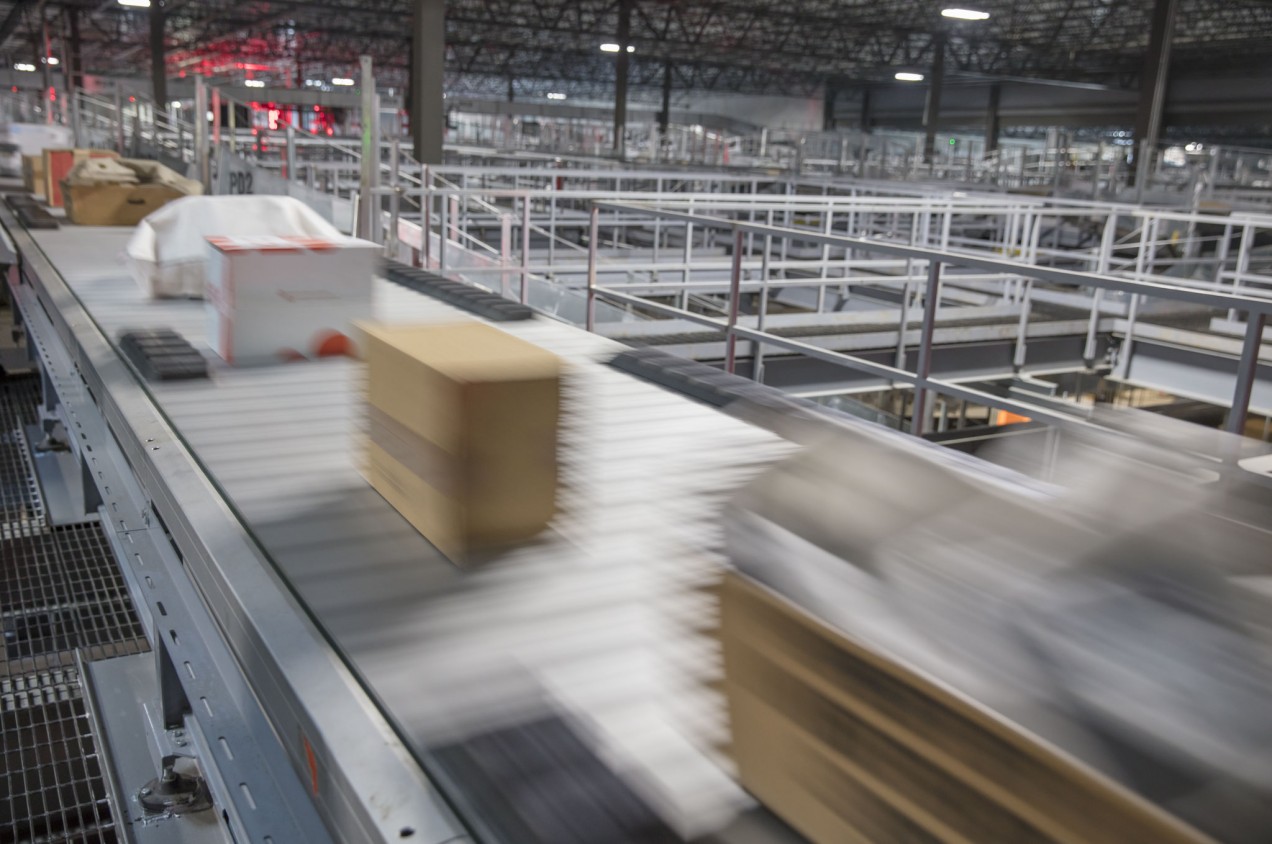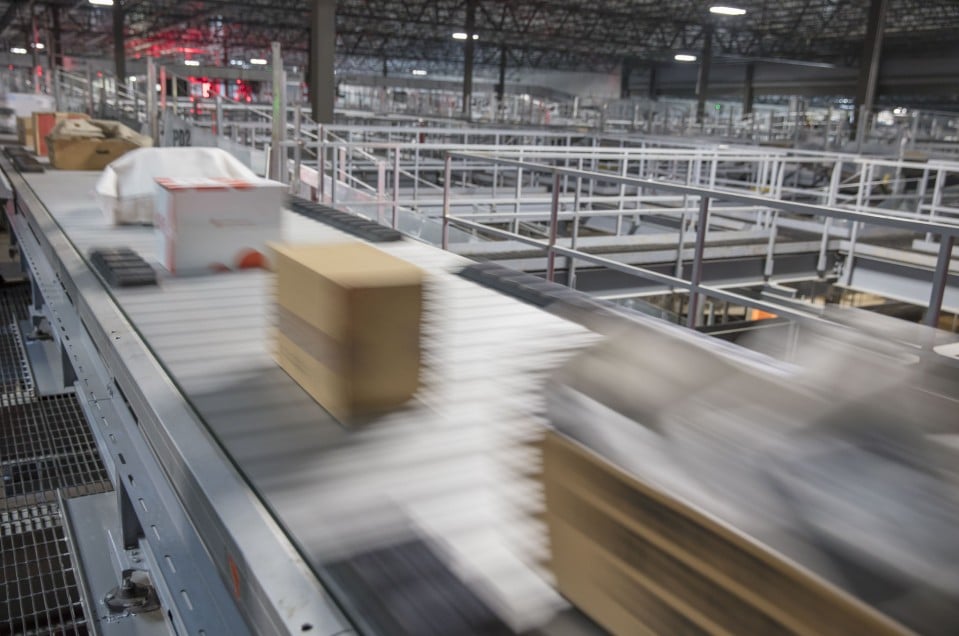

Artificial Intelligence
How UPS uses AI to deliver holiday gifts in the worst storms
The delivery giant’s new machine-learning app aims to reroute packages away from snow and other trouble spots in its global network.

If a snowstorm hits Denver, it can delay thousands of packages that travel through the city before reaching their final destinations on the other side of the country. But if UPS knows a storm is coming, what is the most efficient way to divert all those online orders and holiday gifts around the bad weather?
UPS grapples with this question every winter. Identifying the facility best equipped to handle a large, unplanned shipment and the most efficient way to transport those packages is a tough call for even experienced UPS employees. The variables—among them the types of packages, their destinations, and the deadlines by which they need to be delivered—add complexity that could slow down UPS engineers and make it harder to nimbly shift resources.
To help, UPS recently built an online platform that combines machine learning and advanced analytics. The app—called Network Planning Tools, or NPT for short—lets the company’s engineers view activity at UPS facilities around the world and route shipments to the ones with the most capacity. They can also see details about the packages in transit, including their weight, volume, and delivery deadlines. While UPS already has a system called ORION that maps out last-mile delivery routes, and a technology program called EDGE focused on upgrading UPS's internal processes, NPT gives its engineers a bird’s-eye view of package volume and distribution across its pickup and delivery network.
The app gets some of its smarts from AI, which it uses to create forecasts about package volume and weight based on analysis of historical data. Rob Papetti, who leads NPT development for UPS, says the machine-learning algorithms also analyze decisions the company’s engineers made and assess how they affected customer satisfaction and internal costs. “[The app] starts to learn from itself and suggest this option versus that option, based on what enabled us to give our customers better service,” he says.
That kind of insight is crucial during the frenetic holiday season. This year, UPS expects to deliver more parcels during that period than ever before—nearly 800 million, up 5% from 2017. In preparation, the company has used the NPT app to identify and eliminate bottlenecks, such as an Illinois facility that was struggling to process packages quickly. “Within a few minutes, we were able to determine how to get around and relieve [the backlog in] that building and still make our service commitments to customers,” says Papetti. “Before NPT, that would have taken at least a week.” UPS expects the program to save it $100 million to $200 million a year.
Chris Caplice, who heads MIT’s Center for Transportation & Logistics, says companies like UPS need programs like NPT because they have sprawling road, rail, and air operations and need to be able to switch between the modes quickly. “They have a portfolio of options, of ways they can flow packages [to their destinations], and they’re picking which ones make the most sense,” he says. “This should give them a ton of flexibility during the peak [holiday] season or whenever there’s a disruption.”
***
If you order online from a company that has a shipping contract with UPS, your parcel will probably be categorized by zip code at one of UPS’s large sorting facilities before it is shipped to another facility for local distribution. Inside this “hub,” the package will be unloaded onto a central conveyor belt, tagged with a bar-code label, scanned with cameras, and put on a series of tractor-trailers, planes, or trains until it gets within a few miles of your address. Then UPS will load it onto one of the company’s familiar brown trucks for delivery.
This approach lets UPS organize packages by destination and move them at low cost while still meeting deadlines. It also lets the company’s engineers combine shipments to save time and money—as long as they have accurate information about what’s moving through the network.
Before NPT, that was a challenge. UPS employs at least four types of industrial engineers and transportation planners, including people who coordinate the loading and unloading of trucks and determine work hours and tasks for building employees and pilots. Until September, each of those groups did its own planning—typically just for its own building or location—using consumer software like Microsoft Access and Excel. Groups would e-mail lists to each other, but synthesizing data was difficult, according to Papetti. “You had to spend a lot of time trying to communicate with everyone,” he says. “You’d go, ‘Hey, what are you going to do differently than last year?’ and then you’d have to figure out what their plan meant for you.”
The launch of the NPT app gave those employees a single, cloud-based platform where they could view data and run simulations to help create their plans and schedules. The NPT app also provides the engineers with options that UPS’s algorithms have vetted. Essentially, the algorithms understand the distribution of all the packages in every UPS trailer or plane and can figure out the best way to bypass a problematic location while still meeting deadlines and not overwhelming other UPS facilities.
In the Denver snowstorm scenario, engineers in Portland, Oregon, could log on to NPT, see that a number of Massachusetts-bound packages were heading for trouble, and divert some of them through UPS’s Chicago hub, sending the rest through the one in Meadowlands, New Jersey, to avoid swamping Chicago. Both of those facilities would be able to sort the packages and send them on for local distribution in time to fulfill UPS’s contracts. The app would not list UPS’s hub in Greensboro, North Carolina, as an option because that facility doesn’t have as much space for loading tractor-trailers bound for the Northeast and thus would not be a good detour.
Once the packages were rerouted, the NPT app would send UPS engineers in Chicago and New Jersey notifications so they could prepare for the influx. UPS is also linking the app into its facility automation systems and plans to use it to issue package-sorting instructions by April 2019. When packages are rerouted, facilities will be able to recognize those parcels and sort them into the correct chutes automatically.
Another NPT feature helps engineers group all their outbound packages into the smallest possible number of trailers or cargo planes. NPT can also schedule truck and plane trips so those drivers and pilots always pick up parcels on their return trips and never return home with empty vehicles. Like the rest of the app, these features enable UPS employees to look at a number of alternatives, assess them, and put them into action. Papetti describes the app as a big-data platform with a simulation engine that tells users the ramifications of every decision they make.
***
UPS has caught flak in the past for developing software that appears to disregard employees’ knowledge and preferences in the name of efficiency. That’s how some people think of ORION, which the company began deploying in 2012. But the NPT app lets the company’s engineers ignore the algorithms and create their own plans, at least for now. While it gives suggestions and prepopulates forecast data into certain fields, the engineers are the ones who ultimately route the packages. Papetti says he will ask engineers to explain why they followed their own ideas and supply supporting evidence so his group can refine the NPT software. “We want to give the [engineers] the opportunity to say, ‘Hey, that’s wrong’ and make this a learning platform for our algorithms and AI,” he says.
There’s hope that NPT could help improve communication with customers as well. Logistics expert Mick Mountz, who founded and ran the warehouse-robot startup Kiva Systems (now Amazon Robotics), thinks that NPT’s tracking ability could give customers better visibility into UPS’s network, end to end. “When you ship a critical package, you want to get something like a text message every few hours as it moves through the supply chain,” he says. “A service like this enables the end business to be more efficient. Visibility at large is a useful thing, though it’s hard to put a value on.”
Papetti says he’s talking to people within UPS about using this new level of data and control to customize the way the company treats certain packages, such as routing pharmaceuticals away from areas with desert climates like Phoenix.
Caplice, the MIT professor, says NPT’s value will depend on UPS’s commitment to supporting the app, integrating it into its operations, and rolling out new features, which the company says it will do every three months through 2021. “Making these kinds of decisions on the fly is really hard,” he says. “If they can truly be that dynamic, it’ll be an awesome capability, but there are lots of complications involved in doing this on a large scale.”